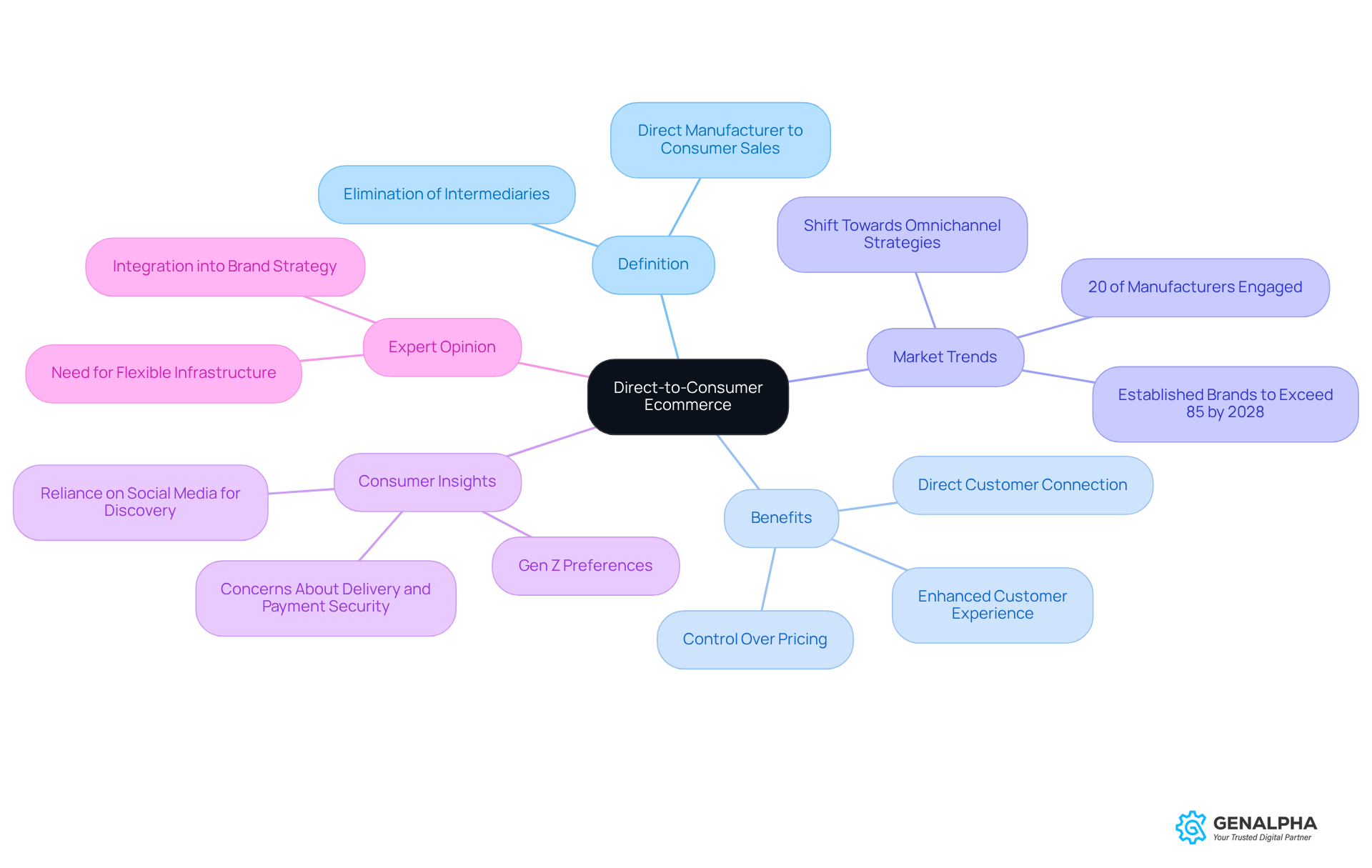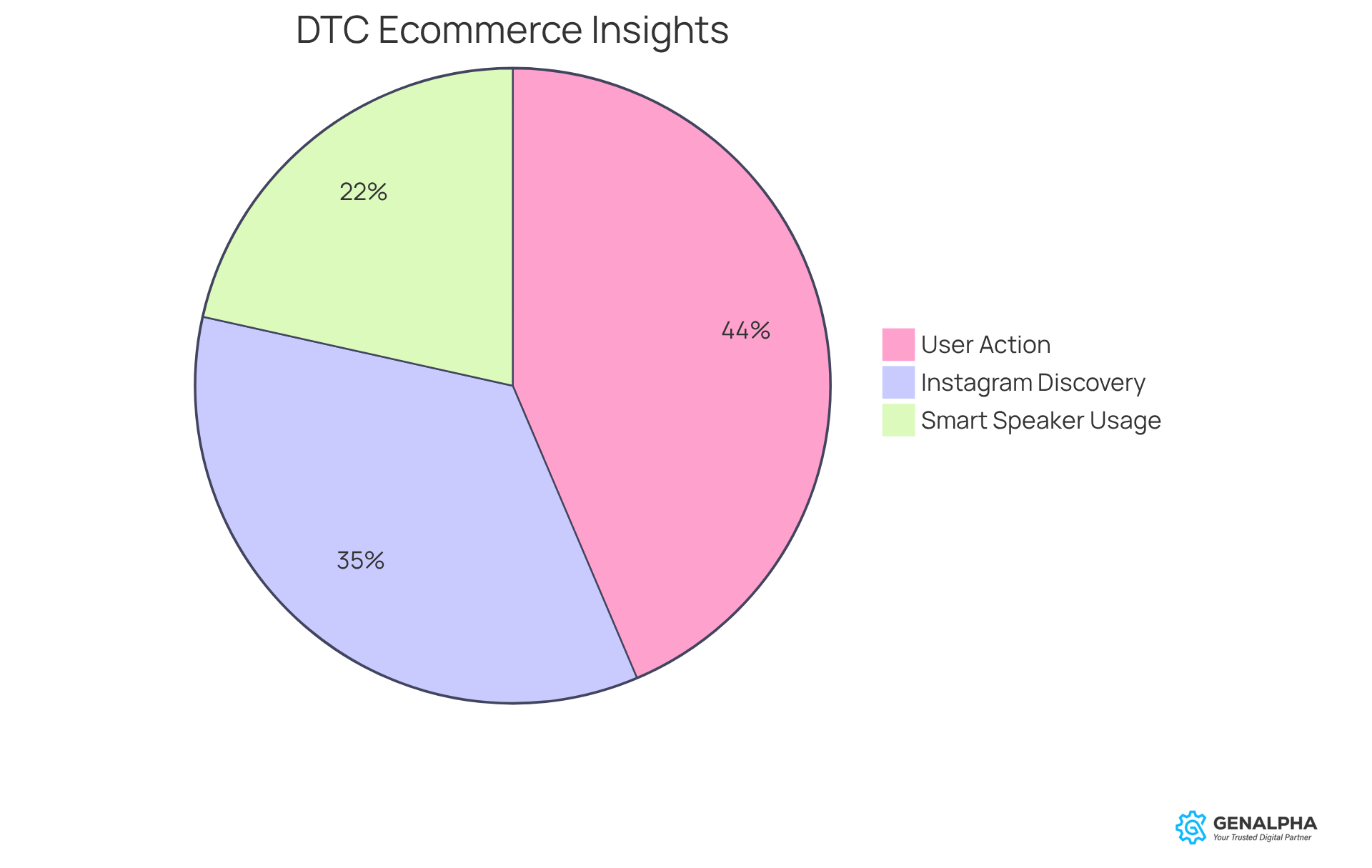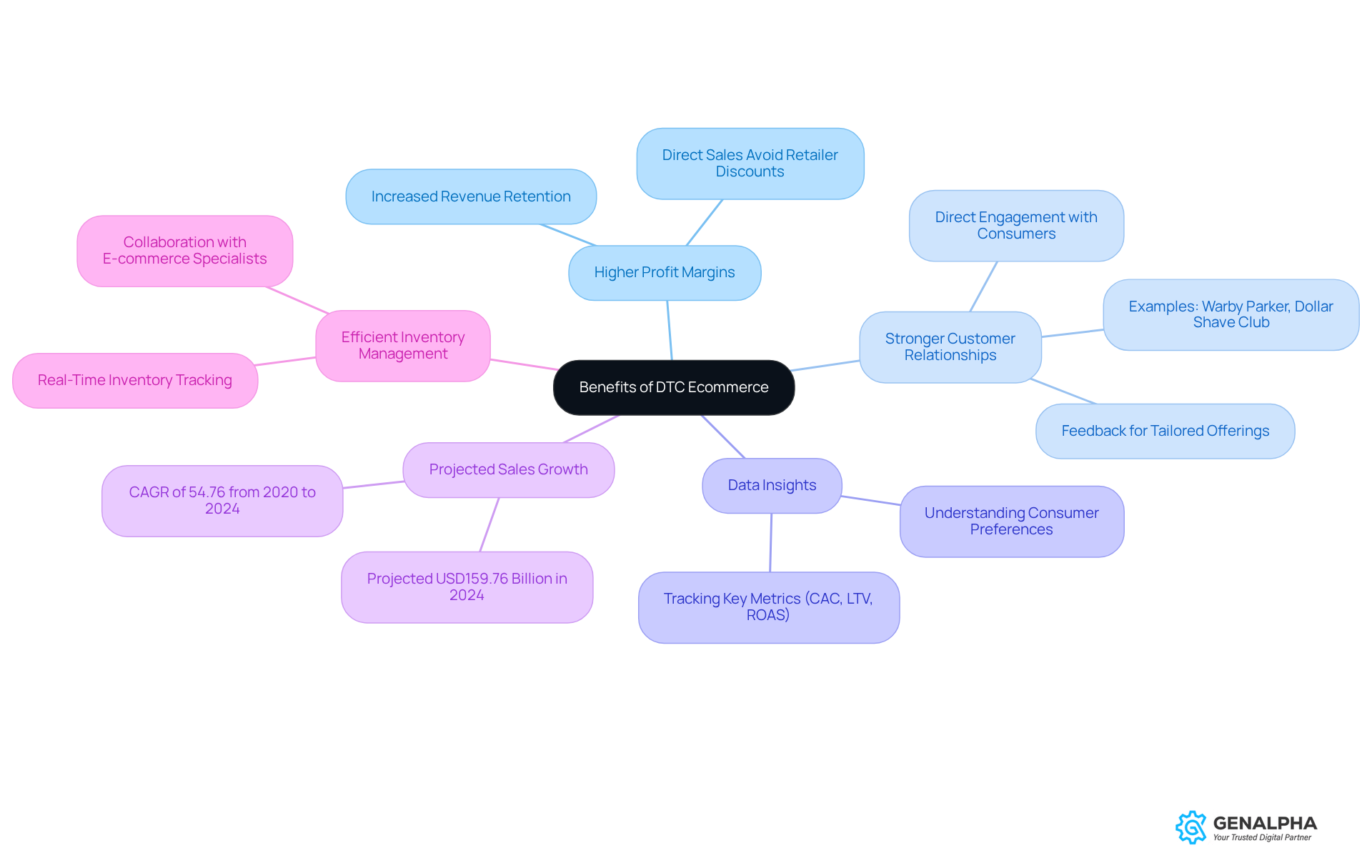Overview
Have you noticed the rise of direct-to-consumer (DTC) ecommerce among equipment manufacturers? It’s a fascinating trend that’s reshaping how these businesses connect with customers. By selling directly to consumers, manufacturers can boost their profits and strengthen customer relationships. Sounds great, right?
However, it's not all smooth sailing. To make this model work, significant investments in digital infrastructure and logistics are essential. Think about it: without the right tools and systems in place, the benefits of DTC can quickly turn into challenges.
So, what does this mean for manufacturers? Embracing DTC ecommerce could be a game-changer, but it requires careful planning and commitment. Are you ready to explore this exciting opportunity?
Introduction
Direct-to-consumer ecommerce is shaking things up! It’s changing how manufacturers connect with their customers by cutting out the middlemen, which means a more personalized shopping experience for all of us. This shift not only boosts profit margins but also helps brands build stronger relationships with consumers. Imagine being able to tailor offerings based on direct feedback—how cool is that?
But let’s be real: as this model takes off, manufacturers are facing some hefty challenges. From investing in digital infrastructure to figuring out the logistics and fulfillment maze, it’s no small feat. So, how can they adapt to this ever-evolving landscape and still enjoy the perks of direct-to-consumer sales? It’s a big question worth exploring!
Define Direct-to-Consumer Ecommerce
Direct-to-consumer ecommerce involves manufacturers selling their products directly to you, the consumer, eliminating intermediaries such as retailers and wholesalers. This approach allows companies to connect directly with their customers, giving them more control over their identity, pricing, and overall customer experience. It’s no wonder that direct-to-consumer ecommerce has become increasingly popular, especially as digital platforms make online shopping easier and more efficient than ever.
Did you know that nearly 20% of manufacturers have jumped on the direct-to-consumer ecommerce bandwagon? That’s a clear sign that businesses are embracing this direct sales model. And it gets even more interesting—big-name companies are expected to dominate the direct-to-consumer ecommerce space, with their share projected to soar past 85% by 2028. Plus, social media and online ads are becoming the go-to ways for product discovery, especially among Gen Z consumers.
Industry experts are stressing the need to adapt to these changes. Jeff Wray, Senior Managing Director and Leader of the U.S. Retail & Consumer Products Practice, put it well when he said, 'Direct-to-consumer ecommerce is no longer just a brand identity; it must be integrated into the broader strategy of most brands to remain competitive.' This highlights how crucial it is for companies to streamline their communication channels and invest in flexible infrastructure to improve cross-channel capabilities. By doing so, producers can not only boost customer engagement but also enhance sales efficiency in a marketplace that’s getting tougher every day. So, how are you planning to navigate these changes?

Contextualize the DTC Model in Ecommerce
The direct-to-consumer ecommerce model has evolved significantly since it first appeared in the early days of ecommerce, primarily serving niche markets. Fast forward to today, and it’s a go-to strategy for manufacturers, thanks to tech advancements and changing consumer habits. Have you noticed how social media and mobile shopping have transformed the game? Companies can now chat with consumers in real-time and customize their marketing to fit individual tastes.
For example, did you know that:
- 60% of people now turn to Instagram to discover new products?
- A whopping 75% of Instagram users take action after seeing posts from brands?
That really shows how vital Instagram has become in DTC strategies! And if we look at the bigger picture, global ecommerce sales are expected to reach $7.4 trillion by 2025, with social commerce revenue set to jump by 22% from 2024. This means direct-to-consumer ecommerce isn’t just a passing trend; it’s become a standard practice for manufacturers eager to enhance customer relationships and streamline sales processes.
As more companies embrace subscription models and harness AI for personalized experiences, the DTC landscape is continually evolving. This evolution opens up exciting new avenues for growth and customer loyalty. Have you heard about the rise of voice-activated shopping? With 37% of smart speaker owners using their devices for shopping, it’s clear that consumer behavior is shifting in ways that are super relevant to direct-to-consumer ecommerce.
Additionally, video content is becoming increasingly important in ecommerce. In fact, 87% of brands now use videos for marketing, and 69% of consumers say that product demos help them make buying decisions. So, how are you planning to adapt to these changes in the DTC landscape?

Explore the Benefits of DTC Ecommerce
The advantages of direct-to consumer ecommerce are extensive and impactful, wouldn’t you agree? By cutting out the middlemen, manufacturers can enjoy higher profit margins by utilizing direct-to-consumer ecommerce, selling products directly to consumers at retail prices. This model not only boosts profitability but also builds stronger customer relationships through direct-to consumer ecommerce. When companies engage directly with their customers, they gather valuable feedback, allowing them to tailor their offerings to meet consumer needs more effectively.
Additionally, direct-to consumer ecommerce provides critical data insights, helping manufacturers understand consumer preferences and behaviors on a deeper level. For example, look at companies like Warby Parker and Dollar Shave Club—they’ve successfully used DTC strategies to cultivate loyal customer bases and achieve remarkable growth. Did you know that direct-to consumer ecommerce sales by established brands are projected to hit around USD159.76 billion in 2024? That’s a compound annual growth rate of 54.76% from 2020 to 2024! This tremendous growth really highlights the importance of adopting a direct-to consumer ecommerce approach in today’s competitive landscape, where understanding and responding to customer needs is key.
Furthermore, efficient inventory management and collaborations with e-commerce specialists and fulfillment providers are crucial for expanding direct-to consumer ecommerce operations. This ensures that producers can meet demand effectively while maintaining those strong customer relationships. So, are you ready to explore the potential of DTC eCommerce for your business?

Identify Challenges in Adopting DTC Ecommerce
The direct-to-consumer (DTC) approach has its perks, but it also comes with its fair share of challenges for producers. One major hurdle is the need to invest in solid digital infrastructure, which can mean some hefty upfront costs. Did you know that direct-to-consumer ecommerce sales in the U.S. are projected to reach a whopping $186.6 billion by 2025? That really shows the growth potential of this model! Plus, a staggering 94% of global ecommerce leaders are planning to ramp up in-country fulfillment in the next five years, underlining just how crucial logistics are in this game. With competition heating up in the busy ecommerce scene, producers need to craft smart marketing strategies to set themselves apart.
Logistics and fulfillment can be particularly tricky. Timely delivery and efficient inventory management are key. In fact, by 2025, 63% of decision-makers are saying that faster delivery speeds will be a top reason for in-country fulfillment. This really highlights the need for manufacturers to streamline their operations. Transitioning to a direct-to-consumer ecommerce model often means a cultural shift within organizations, where teams have to adapt to new processes and enhance their customer engagement strategies. As Smart Warehousing points out, "with access to real-time inventory tracking, you gain full visibility into stock levels, enabling data-driven decisions that help prevent costly delays or stockouts."
Look at brands like Nike and Glossier—they’ve successfully tackled these challenges and shown that overcoming logistical hurdles can lead to stronger customer connections. Their journeys illustrate how DTC companies can build lasting relationships by focusing on authenticity and personalized interactions. As one expert put it, "DTC provides a more personal connection between the brand and the consumer." So, as manufacturers weigh the decision to adopt the DTC model, it’s essential to grasp these challenges and the investments needed to succeed.

Conclusion
Direct-to-consumer ecommerce is really shaking things up in how manufacturers connect with consumers. It’s all about creating a smoother and more personalized shopping experience. By cutting out the middlemen, companies not only boost their profit margins but also build stronger relationships with their customers. This approach has grown from being just a niche market to a mainstream strategy, thanks to tech advancements and changing consumer habits.
Did you know that nearly 20% of manufacturers are already diving into direct-to-consumer ecommerce? Projections suggest that established brands will take the lead in this space by 2028. It’s crucial to leverage digital platforms, especially social media, as they’re key channels for product discovery and engaging with consumers. While the perks of DTC ecommerce are significant—like better customer insights and increased profits—manufacturers also face challenges such as logistics, digital infrastructure, and crafting effective marketing strategies.
So, what does this mean for manufacturers? Embracing direct-to-consumer ecommerce isn’t just a choice; it’s a must for those looking to thrive in a competitive market. Connecting directly with consumers opens up exciting opportunities for innovation, customer loyalty, and sustained growth. As the landscape keeps changing, manufacturers need to adapt their strategies to fully tap into the potential of DTC ecommerce, ensuring they stay relevant and competitive in this dynamic environment.
Frequently Asked Questions
What is direct-to-consumer ecommerce?
Direct-to-consumer ecommerce involves manufacturers selling their products directly to consumers, bypassing intermediaries like retailers and wholesalers. This model allows companies to have more control over their identity, pricing, and customer experience.
Why is direct-to-consumer ecommerce becoming popular?
The popularity of direct-to-consumer ecommerce is increasing due to the ease and efficiency of online shopping facilitated by digital platforms. Nearly 20% of manufacturers have adopted this sales model, indicating a significant shift in the market.
What is the projected market share for direct-to-consumer ecommerce by 2028?
It is projected that big-name companies will dominate the direct-to-consumer ecommerce space, with their market share expected to exceed 85% by 2028.
How are social media and online ads influencing direct-to-consumer ecommerce?
Social media and online advertisements are becoming primary channels for product discovery, particularly among Gen Z consumers, which is reshaping how brands connect with their audience.
What do industry experts recommend for companies in relation to direct-to-consumer ecommerce?
Industry experts emphasize the importance of integrating direct-to-consumer ecommerce into a broader brand strategy to remain competitive. Companies should streamline communication channels and invest in flexible infrastructure to enhance cross-channel capabilities, customer engagement, and sales efficiency.




